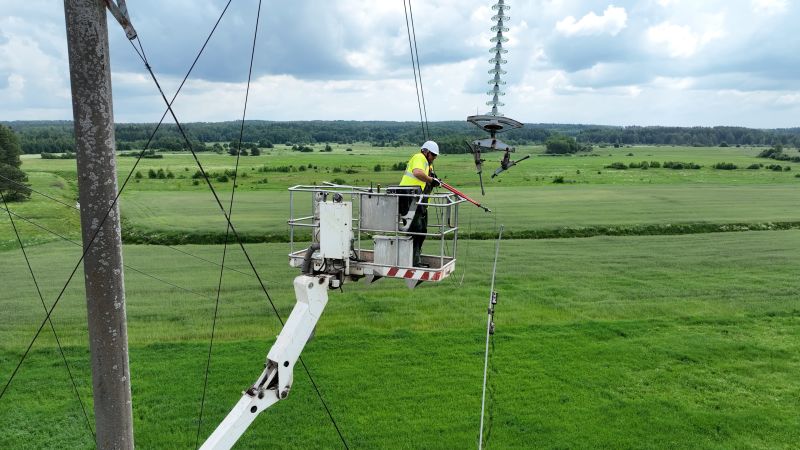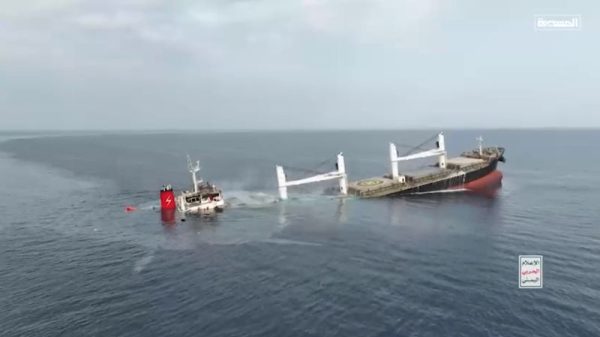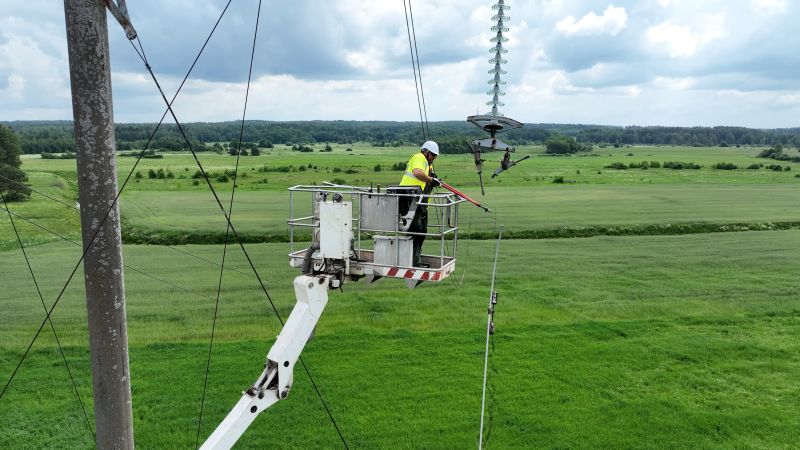
“How to prepare for a power outage?” reads the Facebook post from the Estonian Rescue Board, the country’s civil defense agency. The picture shows a young woman holding up a power bank, over a table loaded with water bottles, a flashlight and other emergency supplies.
Estonia, along with fellow Baltic states Latvia and Lithuania, is counting down the days to finally ridding itself of one of the last vestiges of 50 years of Soviet occupation: an electricity grid controlled by Russia.
Preparing the population for what most see as the unlikely scenario of power outages is the final stage in a years-long project. “Everything should flow smoothly,” reads the rescue board post, “but unexpected situations can arise… whether that be because of the actions of our hostile neighbor to the East, unexpected weather conditions or technical failures.”
The Baltics have been getting ready for this moment for almost the entire two decades since they joined the EU and NATO in 2004. They’ve renovated existing infrastructure, and built new power lines including several undersea cables to Finland and Sweden and a crucial overland link to the mainland European grid, the LitPol line linking Lithuania and Poland.
That meant that just a few months after Russia launched its full-scale invasion of Ukraine in 2022, all three countries were able to stop buying electricity from Moscow.
But Russia was still in total control of the functioning of the grid, balancing supply and demand, and maintaining the frequency, said Susanne Nies, project lead at the German energy research institute Helmholtz-Zentrum. And, in another holdover from Soviet times, it was still providing these services for free.
Six months ago, the Baltic countries officially notified Russia of their intention to “desynchronize” and so, on February 7, the so-called BRELL (Belarus, Russia, Estonia, Latvia, Lithuania) agreement that governs the shared grid will expire.
On February 8, Estonia, Latvia and Lithuania will simultaneously disconnect from that grid, at which point they will need to briefly function as an “island,” surviving only on the electricity they produce. On February 9, they plan to synchronize their newly independent grid with the Continental Europe Synchronous Area, which covers most of the European Union.
It’s a highly symbolic moment. Outside the Energy and Technology Museum in the center of Lithuania’s capital, Vilnius, a countdown clock has been ticking down the last 100 days to “energy independence.” “This is the final break from its Soviet-era occupation,” said Jason Moyer, a foreign policy analyst at the Wilson Center, a think tank in Washington. “Psychologically, this is a huge step forward.”
The project has involved significant investment, most of it from the European Union, which has provided grants worth over $1.2bn. But for the Baltics, the price of allowing Moscow to maintain that leverage over their power grid was too high. “We understand fairly well that the cheap Russian energy, it always comes at a price that no democratic European country should be able to afford,” said Päi.
And lest there be any doubt as to their resolve, last year Lithuania’s grid operator Litgrid started cutting old Soviet cables that formed connections to Belarus so the lines could be repurposed.
The question plaguing Baltic leaders now, as some of the most vocal opponents of the war in Ukraine and some of the most generous donors (as a percentage of GDP) to Ukraine’s military, is whether Russia will try to exploit the moment of disconnection, be it through physical sabotage or another hybrid tactic like cyberattacks or disinformation.
Ukraine had in fact disconnected from the Russian grid for a test just hours before Russia launched its full-scale invasion on February 24, 2022. It never reconnected.
Russia has shown itself more than willing to weaponize electricity supply, not only through repeated attacks on the Ukrainian energy grid, but also through its almost three-year occupation of the Zaporizhzia nuclear plant, which before the war provided about a fifth of Ukraine’s electricity.
For Russia, the loss of leverage over the Baltics, former Soviet vassals, is a geopolitical defeat, said Moyer, adding: “I think this really shows that Russia is losing influence in the region,” one that was “traditionally more receptive to Russian business.” The Kremlin declined to comment, noting only that Russia had taken all necessary measures to ensure the “uninterrupted and reliable operation of our unified energy system.”
“We are increasing our surveillance efforts, we are increasing our additional security measures, and… we are going to watch this with an eye of a hawk,” Šakalienė said.
NATO has now set up a new mission to protect undersea cables in the Baltic Sea, after the Estlink 2, a critical part of the Baltics’ post-Soviet electricity infrastructure, was damaged on Christmas Day, the latest in a series of incidents involving disruption to the complex web of cables criss-crossing the Baltic Sea floor.
Grid operators in Finland and the Baltic states assured customers in the days afterward that supplies were secured. But electricity prices did tick up in late December, and the repairs, according to Finnish authorities, will take until August.
Finland is still investigating the incident, but police have detained a ship carrying Russian oil products, suspected of dragging its anchor across the cable. A lawyer representing the owner of the ship last week called any allegation of sabotage “nonsense.”
One area neither NATO nor the Baltics can police is Kaliningrad. The tiny Russian exclave sandwiched between Lithuania and Poland will now have to function as an electricity “island,” and while Russia has carried out multiple successful tests of its ability to cope, experts are not ruling out deliberate action by Moscow to stir up tensions.
“Russia might even provoke a fake blackout in the region and say ‘Hey, Kaliningrad, this is even the result of the Baltic synchronization,’” said Nies. She believes Russia could then accuse the Baltics of plunging the one million residents of Kaliningrad into darkness and use that to exact concessions, and assess NATO’s appetite to come to the aid of its eastern flank.
The risk may be higher now, with a new administration in Washington that is critical of NATO and determined to end the war in Ukraine. “(The Russians) want to see if NATO is alive, and where do you test it other than in the Baltics?” said Nies.







































